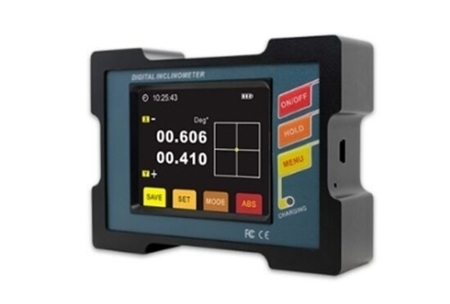Digital inclinometer is a measuring instrument widely used in various fields. It detects the tilt angle of an object relative to the direction of gravity and displays it on the digital display in real time. It can be used to accurately measure parameters such as inclination, tilt, and level. The following will introduce the working principle, types and applications of digital inclinometers.

Working principle
The digital inclinometer is mainly composed of two parts: a sensor and a digital display screen. Sensors usually use MEMS technology and include tiny electronic components such as gyroscopes and accelerometers. When the object tilts, the sensor will sense the tilt angle and transmit the corresponding electrical signal to the digital display for processing. The digital display converts the electrical signal into a digital signal, calculates the tilt angle through a built-in algorithm, and finally displays it on the display.
Application
Digital inclinometers are widely used in engineering surveying, building construction, road construction and other fields. In engineering surveying, digital inclinometers can help engineers measure the straightness and levelness of the horizon to ensure the stability and construction quality of buildings. In construction, digital inclinometers can be used to adjust the verticality and horizontality of walls to ensure the overall beauty and structural stability of the building. In road construction, digital inclinometers can be used to adjust the slope and smoothness of the road to improve driving safety and comfort.
In addition, digital inclinometers are also widely used in sports equipment, aerospace and other fields. On sports equipment, digital inclinometers can be used to measure the inclination of sports equipment such as skis and skateboards, and provide athletes with performance data and improvement suggestions. In aerospace, digital inclinometers can be used to measure the attitude angle of aircraft and rockets, and maintain balance and flight stability through timely adjustments.

Types
Inclinometers come in various types, each tailored to specific measurement needs. Here is a detailed explanation of different inclinometer types:
- Single-Axis Inclinometers: Single-axis inclinometers measure tilt along a single axis or plane, typically the horizontal or vertical plane. They are ideal for applications where tilt is predominantly in one direction.
- Dual-Axis Inclinometers: Dual-axis inclinometers measure tilt along two perpendicular axes. This type provides more comprehensive information about the orientation of an object or surface, offering measurements in both the horizontal and vertical directions.
- Three-Axis Inclinometers: Three-axis inclinometers measure tilt along three orthogonal axes, providing a complete three-dimensional view of an object's orientation. These are often used in applications where the incline can occur in any direction.
- MEMS (Micro-Electro-Mechanical Systems) Inclinometers: MEMS inclinometers utilize micro-scale mechanical components and sensors to measure inclination. They are known for their compact size, low power consumption, and suitability for applications where space is limited.
- Tilt Sensors: Tilt sensors, often integrated into inclinometers, are designed to detect and measure angular displacement or inclination. They can be single-axis or multi-axis, and their simplicity makes them suitable for various applications.
- Digital Inclinometers: Digital inclinometers provide angle readings in a digital format, typically displayed on an electronic screen. They are user-friendly, offer precise measurements, and are commonly used in construction, manufacturing, and alignment tasks.
- Wireless Inclinometers: Wireless inclinometers communicate angle measurements wirelessly, allowing for remote monitoring and data collection. They are particularly useful in applications where a wired connection is impractical or challenging.
- Gravity-Based Inclinometers: Gravity-based inclinometers rely on the Earth's gravitational pull to determine the angle of tilt. These instruments often use a weighted pendulum or a similar mechanism to indicate the inclination of the object.
- High-Precision Inclinometers: High-precision inclinometers are designed for applications that demand extremely accurate angle measurements. They may feature advanced sensors and calibration capabilities to ensure accuracy in critical tasks.
The digital inclinometer is a powerful measuring equipment with a wide range of applications. It senses the tilt angle through a sensor and displays it on the digital display in real time to help users make accurate measurements and adjustments. Whether it is engineering surveying, building construction, sports equipment, or aerospace, digital inclinometers play an important role and improve work efficiency and accuracy.

